
Montana is a state in the Mountain West division of the Western United States. It is bordered by Idaho to the west, North Dakota and South Dakota to the east, Wyoming to the south, and the Canadian provinces of Alberta, British Columbia, and Saskatchewan to the north. It is the fourth-largest state by area, the eighth-least populous state, and the third-least densely populated state. Its state capital is Helena, while the largest city is Billings. The western half of Montana contains numerous mountain ranges, while the eastern half is characterized by western prairie terrain and badlands, with smaller mountain ranges found throughout the state. The state has a reputation for a libertarian bent in popular opinion and policy.

Western Montana is the western region of the U.S. state of Montana. The most restrictive definition limits western Montana only to the parts of the state west of the Continental Divide. Other common definitions add in the mountainous areas east of the divide including Beaverhead, Gallatin, Jefferson, Lewis and Clark, Madison, and Park Counties. The region is sometimes considered to be part of the Inland Northwest.

The University of Montana Western (UMW) is a public college in Dillon, Montana. It is affiliated with the University of Montana and part of the Montana University System. It was founded in 1893 as Montana State Normal School and was also the Western Montana College of the University of Montana before becoming part of the Montana University System in 2000. Enrollment of full-time, degree seeking students as of Fall 2018 was 1,221 students.
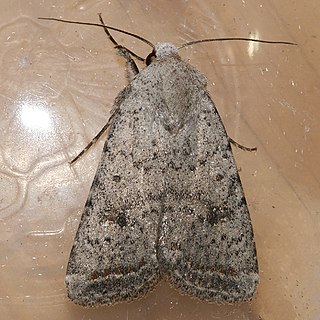
The Caradrinini are a mid-sized tribe of moths in the family Noctuidae.

Caradrina morpheus, the mottled rustic, is a moth of the superfamily Noctuoidea. The species was first described by Johann Siegfried Hufnagel in 1766. It is found across the Palearctic from northern Europe to Siberia, Amur and Korea. Also in Armenia and Turkestan. It was accidentally introduced on both the east and west coasts of Canada and is so far reported in the east from New Brunswick to Ontario, and in the west from British Columbia.

Caradrina clavipalpis, the pale mottled willow, is a moth of the family Noctuidae. The species was first described by Giovanni Antonio Scopoli in his 1763 Entomologia Carniolica. It is found in the Palearctic realm. It is an introduced species in North America, where it was first reported from Queens in New York City in 1993. In 2009 it was found in Rochester, New York, so it appears to be established and spreading.

Caradrina kadenii, or Clancy's rustic, is a moth of the family Noctuidae. The species was first described by Christian Friedrich Freyer in 1836. It originates from southern and central Europe, Asia Minor and southern Russia but in the 21st century it has extended its range to the north.
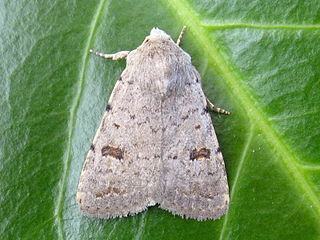
Caradrina is a genus of moths of the family Noctuidae. The genus was erected by Ferdinand Ochsenheimer in 1816. It is divided into eight subgenera, including Paradrina and Platyperigea, which are treated as separate genera by some authors.

Caradrina gilva is a moth of the family Noctuidae. It is endemic to southern Central Europe.The eastern distribution extends to the Middle East up to Turkey. In the Alps it reaches heights of about 1600 meters. Isolated records in other regions indicate that the species is sometimes migratory and it has recently been expanding its range. The first sighting in Spain was in 2007 and in The Netherlands June 1, 2009 in Geulle.The main habitat is warm, rocky mountain slopes, occasionally also grassy areas.
Caradrina meralis, the rare sand Quaker, is a moth of the family Noctuidae. The species was first described by Herbert Knowles Morrison in 1875. It is found in North America from New Jersey and New Hampshire, Ontario, Ohio and Wisconsin west across southern Canada to British Columbia, south to California and Arizona.

Caradrina multifera, the speckled rustic moth, is a moth of the family Noctuidae. The species was first described by Francis Walker in 1857. It is found in North America from Newfoundland to North Carolina and Tennessee and west to Minnesota and Manitoba. It is also present in British Columbia and Washington.
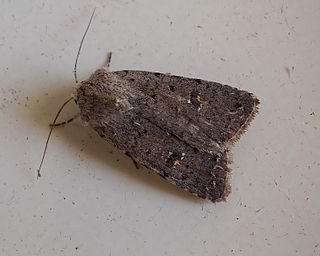
Caradrina flavirena is a moth of the family Noctuidae. It was described by Achille Guenée in 1852. It is found in Morocco, Algeria, southern Europe, Turkey, Israel, Lebanon, Jordan, Syria, Armenia and Iran. The habitat consists of grasslands.
Caradrina vicina is a moth of the family Noctuidae. It was described by Staudinger in 1870. It is found from Central and Southeastern Europe, eastern and central Anatolia, and Western to Central Asia. The habitat consists of grasslands.
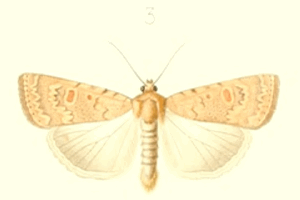
Caradrina flava is a moth of the family Noctuidae. It was described by Charles Oberthür in 1876. It is found in Spain and Greece and on Malta and the Canary Islands, as well as from the Sahara to the Arabian Peninsula, Israel, Jordan, the Levant, Iran and Iraq.

Caradrina selini is a moth of the family Noctuidae. It was described by Jean Baptiste Boisduval in 1840. It is found in most of Europe, North Africa and the Near East.
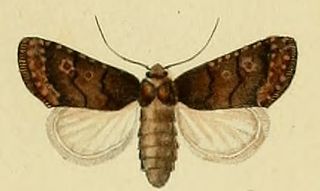
Caradrina germainii is a moth of the family Noctuidae. It was described by Philogène Auguste Joseph Duponchel in 1835. It is found in south-western Europe and North Africa. It is found mostly in garigue habitats.
Caradrina camina is a species of cutworm or dart moth in the family Noctuidae. It is found in North America.
Caradrina atrostriga is a species of cutworm or dart moth in the family Noctuidae. It was first described by William Barnes and James Halliday McDunnough in 1912 and it is found in North America.
Caradrina petraea is a moth belonging to the family Noctuidae. The species was first described by Johan Martin Jakob von Tengström in 1869.














